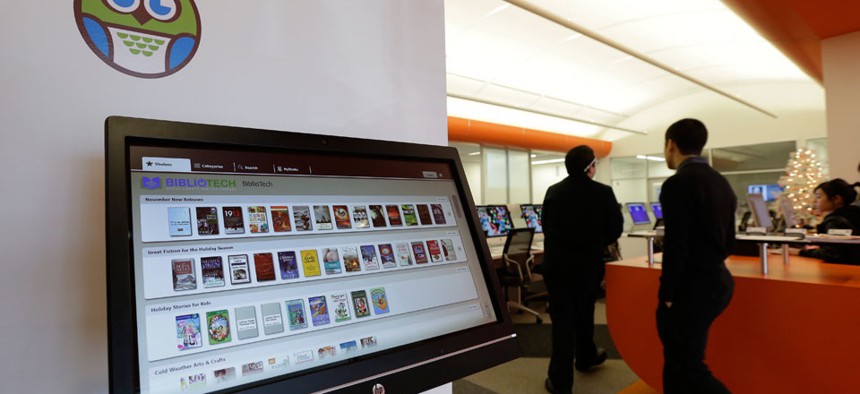Adapting America's Public Libraries for the Digital Age

A computer screen displays books available at BiblioTech, a first-of-its-kind digital public library, in San Antonio. Eric Gay/AP
A new report from the Aspen Institute discusses the future of an important institution.
Book circulation is not the central focus of America's public libraries anymore. Or rather, it shouldn't be if our libraries want to remain relevant, according to a new report released today by the Aspen Institute Dialogue on Public Libraries. The report is the result of a multiyear conversation about the future of America's public libraries and how they can best serve the emerging needs of their communities.
As we move forward into the digital age at what sometimes feels like warp speed, our communities continue to change—and what we need from our libraries continues to change, too. "While the public library was conceived in an age of information scarcity, today's networked world is one of information abundance and mobility," states the report. "Public libraries have the DNA needed to thrive in this new information-rich, knowledge-based society."
It's not just librarians and policymakers who see this need for adaptation; library users also feel the need for the institution to become more dynamic. As Deborah Fallows wrote last week in The Atlantic , the Columbus Metropolitan Library of Columbus, Ohio, recently asked its Facebook fans to share five words describing their childhood libraries and five words describing how they imagine libraries two decades from now. Here are the results, presented in two word clouds:

Words describing libraries of yesterday.

Words describing libraries of the future.
Books still undeniably have their place, but this informal poll suggests that the library of the future will shift its priorities: It won't be so much about keeping quiet as about meeting other people. It won't be about reading so much as research. It won't be about homework so much as entertainment. Other notable descriptors of the library of the future include "access," "technology," "information," and "Internet."
In order to make the library of the future a reality, the Aspen Institute report suggests that public libraries leverage three of their most important assets: people, place, and platform.
People: The library must "shift away from building collections to building human capital." This not only refers to the users of the public library but also its librarians, who will act as curators of the library's content.
Place: The public library of the future is both a physical and virtual place. While the latter gets emphasized—perhaps overly so—in discussions about the future, the physical structure of the public library will remain vital to its community. But its purpose will change: "The physical library will become less about citizens checking out books and more about citizens engaging in the business of making their personal and civic identities."
Meanwhile, on the less tangible side of things, the report recommends that the virtual space of the library "must be considered as a wholly independent but highly integrated experience." Experiences in the virtual space must be just as engaging as those in the physical; neither is more or less important than the other.
Platform: America's public libraries should become community learning platforms. They should serve as a jumping-off point for users to create, learn, and innovate. The book catalog alone is not enough, the report says. Libraries will need much more, including new forms of access and distribution infrastructure, to support the needs of their communities.
Most importantly, libraries in the United States must work with one another. "Unification—getting libraries to work together, to integrate their intellectual and capital resources—is a critical platform issue," states the report. The ideal is a national digital public library model with a single interface. While the specifics of that vision are not outlined, the report notes that models for such a platform already exist, including the Digital Public Library of America , which launched early last year .
All of us have a stake in the evolution of our public libraries. By embracing these three primary assets, the report argues that that these unique community spaces can continue to adapt to the needs of their communities while maintaining their essence in the 21st century: "providing access to knowledge and promoting literacy."
NEXT STORY: States Ascend Into the Cloud





